Emerging phytotechnologies for remediation of heavy meal contaminated/ polluted soil and water
M.N.V. PrasadDepartment of Plant Sciences, |
Abstract
The present world is facing problems with a wide variety of pollutants and contaminants (both inorganic and organic). Healthy soil, clean water and air are the soul of life. Often soil, water and air are no longer clean and pure, but pose human health risks. The supposedly most pristine environment in arctic circle and Antarctica are not even spared due to global transport of anthropogenic pollutants/contaminants of three major groups viz, i) heavy metals ii) acidifying gases (SOx), and iii) a variety of persistent organic pollutants that play a major role in global climate change. This presentation would concentrate only on inorganic pollutants and application of emerging phytotechnologies for environmental cleanup and restoration.
The contamination of the environment with toxic metals has become a worldwide problem, affecting crop yields, soil biomass and fertility, contributing for the bioaccumulation and biomagnifications in the chain. In the last few decades, research groups have recognised that certain chemical pollutants such as toxic metals may remain in the environment for a long period and can eventually accumulate to levels that could harm humans. Moreover, the numerous classes and types of these chemicals apart from the soil structure complicate the removal of many toxic metals from the environment. As an alternative, an ecological technological approach has been developed involving the use of plants to clean up or remediate soils contaminated with toxic metals. A group of plants, termed "hyper-accumulators" are the best candidates capable of toxic metal uptake, transport and accumulate.
Introduction
A wide range of phytoechnologies have emerged as a feasible technology for environmental restoration (Glass 1999, McCutcheon and Schnoor 2003). The wide recognitions for this approach is supported by the fact that it is considered to be an environmentally friendly technology, safe and also a cheap way to remove contaminants, in some cases doing the same job as a group of engineers for one tenth of the cost.
In this presentation, the upcoming phytotechnologies for inorganic pollutants in soil and water such as phytoextraction, phytostabilisation, phytostimulation, phytovolatilisation, hydraulic barriers for containment of groundwater migration, vegetative caps for containment of landfill leachate, constructed wetlands, riparian buffer zones and buffer zones for stormwater detention, environmental restoration for erosion control, halophytic (salt-loving) plants, environmental crops. Phytotechnologies are being commercialised in the developed world (Glass 1999, McCutcheon and Schnoor 2003) (Figure 1 and 2)
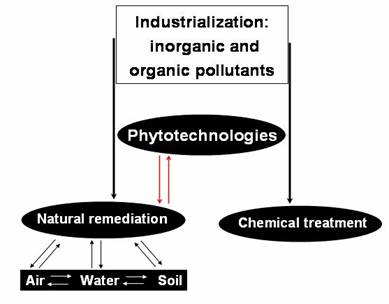
Figure 1: Air- Water- Soil (rhizosphere – plant) continuum, the basis for natural attenuation of
contaminants and pollutants needs critical study for successful implementation of phytotechnologies
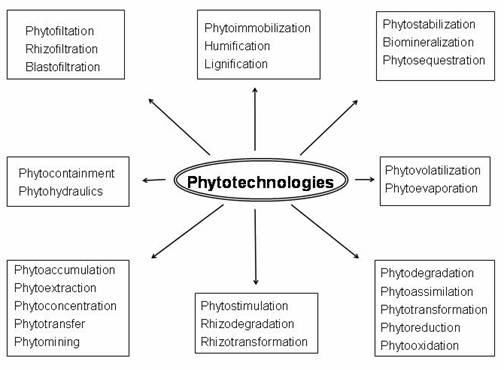
Figure 2: Various sub-processes in phytotechnologies
The contamination of the environment with toxic metals has become a worldwide problem, affecting crop yields, soil biomass and fertility, contributing to the bioaccumulation and biomagnifications in the food chain (Table 1). In the last few decades, research groups have recognised that certain chemical pollutants such as toxic metals may remain in the environment for a long period and can eventually accumulate to levels that could harm humans. Biological and engineering strategies designed to improve the use of phytoremediation to reduce the amount of heavy metals in contaminated soils has begun to emerge (Adriano et al 2004).
Table 1: Distinction between contaminant and pollutant
Contaminant |
Pollutant |
Trace amount in the ambient environment and the organism exposed to contaminant may not show visible toxic symptoms |
Comparatively larger in amount in the ambient environment. The organism exposed would exhibit visible toxic symptoms |
Phytoremediation is a general term for several ways in which plants are used to clean up, or remediate sites by removing pollutants from soil and water. Plants can break down, or degrade, organic pollutants or contain and stabilise metal contaminants by acting as filters or traps. Some of the methods that are being tested are described in this fact sheet. Treating metal contaminants at sites contaminated with metals, plants are used to either stabilise or remove the metals from the soil and groundwater through three mechanisms: phytoextraction, rhizofiltration, and phytostabilisation. Phytoextraction, also called phytoaccumulation, refers to the uptake and translocation of metal contaminants in the soil by plant roots into the aboveground portions of the plants. Certain plants, called hyperaccumulators, absorb unusually large amounts of metals in comparison to other plants. One or a combination of these plants is selected and planted at a particular site based on the type of metals present and other site conditions. After the plants have been allowed to grow for some time, they are harvested and either incinerated or composted to recycle the metals. This procedure may be repeated as necessary to bring soil contaminant levels down to allowable limits. If plants are incinerated, the ash must be disposed of in a hazardous waste landfill, but the volume of ash will be large.
Indigenous microorganisms are those microorganisms that are found already living at a given site. To stimulate the growth of these indigenous microorganisms, the proper soil temperature, oxygen, and nutrient content may need to be provided. If the biological activity needed to degrade a particular contaminant is not present in the soil at the site, microorganisms from other locations, whose effectiveness has been tested, can be added to the contaminated soil. These are called exogenous microorganisms. The soil conditions at the new site may need to be adjusted to ensure that the exogenous microorganisms will thrive.
Essential processes involved in phytoremediation
-
Phytoaccumulation: The uptake and concentration of contaminants (metals or organics) within the roots or aboveground portion of plants.
-
Phytoextraction: Element accumulating plants are established on contaminated soil and later harvested in order to remove the specific elements from the soil.
-
Phytoextraction: The use of plants at waste sites to accumulate metals into the harvestable, above-ground portion of the plant and, thus, to decontaminate soils
-
Phytoextraction coefficient: The ratio of metal concentration in the plant (g metal/g dry weight tissue) to the initial soil concentration of the metal (g metal/g dry weight soil) for phytoextraction of metals.
-
Phytomining: Use of plants to extract inorganic substances from mine ore.
-
Phytoremediation: Use of plants to remediate contaminated soil or water.
-
Phytostabilisation: Plants tolerant to the element in question are used to reduce the mobility of elements, thus, they are stabilised in the substrate or roots.
-
Phytovolatilisation: The uptake and transpiration of a contaminant by a plant, with release of the contaminant or a modified form of the contaminant to the atmosphere from the plant.
-
Rhizofiltration/ phytofiltration: Roots or whole plants of element accumulating plants absorb the element from polluted effluents and are later harvested to diminish the metals in the effluents
-
Rhizosecretion: A subset of molecular farming, designed to produce and secrete valuable natural products and recombinant proteins from roots
Constructed wetlands for water treatment :
Stormwater is an important water resource. Stormwater treatment and management are important topics in tropical countries. In the wake of 2005 Bangalore and Mumbai urban flash floods, all concerned authorities must examine the feasibility of implementing “Sustainable Urban Drainage Systems (SUDS)” a well established operational in developed counties. This is a neglected area in Indian scenario.
The use of aquatic plants in water quality assessment has been common for years as in-situ biomonitors and for in situ remediation. The occurrence of aquatic macrophytes is unambiguously related to water chemistry and using these plant species or communities as indicators or biomonitors has been an objective for surveying water quality. Aquatic plants have also been used frequently to remove suspended solids, nutrients, heavy metals, toxic organics and bacteria from acid mine drainage, agricultural landfill and urban storm-water runoff. In addition, considerable research has been focused on determining the usefulness of macrophytes, as biomonitors of polluted environments and as bioremediative agents in wastewater treatments (Fritioff and Greger 2003, Mohan and Hosetti 1999, Kamal et al 2004, Lytle et al 1998). The response of an organism to deficient or excess levels of metal (i.e. bioassays) can be used to estimate metal impact. Such studies done under defined experimental conditions can provide results that can be extrapolated to natural environment. There are multifold advantages in using an aquatic macrophyte as a study material. Macrophytes are cost-effective universally available aquatic plants and with their ability to survive adverse conditions and high colonisation rates are excellent tools for studies of phytoremediation. Rooted macrophytes especially play an important role in metal bioavailability through rhizosphere secretions and exchange processes. This naturally facilitates metal uptake by other floating and emergent forms of macrophytes. Macrophytes readily take up metals in their reduced form from sediments, which exist in anaerobic situations due to the lack of oxygen and oxidise them in the plant tissues making them immobile and bioconcentrate them to a great extent. Metals concentrated within macrophytes are available for grazing by fish. These may also be available for epiphytic phytoplankton, herbivorous and detrivorous invertebrates. This may be a major route for incorporating metals in the aquatic food chain. It is therefore of interest to assess the levels of heavy metals in macrophytes due to their importance in ecological processes. The immobile nature of macrophytes makes them a particularly effective bio-indicator of metal pollution, as they represent real levels present at that site. Data on phytotoxicity studies are considered in the development of water quality criteria to protect aquatic life, the toxicity evaluation of municipal and industrial effluents (APHA-American Public Health Association 1998). In addition aquatic plants have been used to assess the toxicity of contaminated sediment elutriates and hazardous waste leachates.
In the past research with macrophytes has centred mainly on determining effective eradication techniques for nuisance growth of several species such as Elodea Canadensis, Eichhornia crassipes, Ceratophyllum demersum, etc. Scientific literature exists for the use of wide diversity of macrophytes in toxicity tests designed to evaluate the hazard of potential pollutants, but the test species used is quite scattered. Similarly literature concerning the phytotoxicity tests to be used, test methods and the value of the result data is scattered. Estuarine and marine plant species are being used considerably less than freshwater species in toxicity tests conducted for regulatory reasons. The suitability of a test species is usually based on the specimen bioavailability, sensitivity to toxicant, reported data and the like. The sensitivity of various plants to metals was found to be species and chemical specific, differing in the uptake as well as toxicity of metals. Many submersed plants have been used as test species, but there is no widely used single species. In a literature survey only 7% of 528 reported phytotoxicity tests used macrophytic species (Wang and Freemark 1995). Their use in microcosm and mesocosm studies is even rarer and has been highly recommended. Several plant species like Lemna, Myriophyllum, Potamogeton have been exhaustively used in phytotoxicity assessment, but several others have been given less importance as a bioassay tool. Duckweeds have received the greatest attention for toxicity tests as they are relevant to many aquatic environments, including lakes, streams, effluents. Aquatics encompassing:
Eichhornia crassipes, Elodea Canadensis, Heteranthera dubia, Myriophyllum spicatum, Potamogeton pectinatus, P.richardsonii, Vallisneria American, V. spiralis, Wolffia globosa, Lemna trisulca, Hydrilla verticillata and Typha latifolia have been almost extensively studied both in lab and field.
Metal concentration Factor : [Metal] plant (g/g dry wt)
[ Meta ] water(g/mL)
Pollutants that originate mainly from non-point sources are difficult to control. Constructed wetlands are designed to intercept and remove a wide range of contaminants from wastewater. These wetlands can save time and money by using natural mechanisms to treat non-point source pollution before it reaches lakes, rivers, and oceans. Conventional wastewater treatment plants can effectively remove non-point source pollution, but are expensive to build and operate on. Therefore, local wastewater treatment plants are desirable to reuse water.
The most important role of plants in wetlands is that they increase the residence time of water, which means that they reduce the velocity and thereby increase the sedimentation of particles and associated pollutants. Thus, they are indirectly involved in water cleaning. Plants also add oxygen, providing a physical site of microbial attachment to the roots generating positive conditions for microbes and bioremediation. For efficient removal of pollutants, a high biomass per volume of water of the submerged plants is necessary. Uptake of metals in emergent plants only accounts for 5% or less of the total removal capacity in wetlands. Not many studies have been performed on submerged plants, however, higher concentration of metals is submerged than emerged plants has been found and in microcosm wetland, the removal by Elodea canadensis and Potamogeton natans showed up to 69 % removal of Zn. (Kadlec 1995; Kadlec and Knight 1996)
Constructed and engineered wetlands for water treatment (Figures 3-8; Okurut et al 1999)
Natural wetlands :
used for wastewater treatment for centuries
uncontrolled discharge irreversible degradation.
Constructed wetlands :
effective in treating organic matter, nitrogen, phosphorus, decrease the concentrations of heavy metals,
organic chemicals, and pathogens
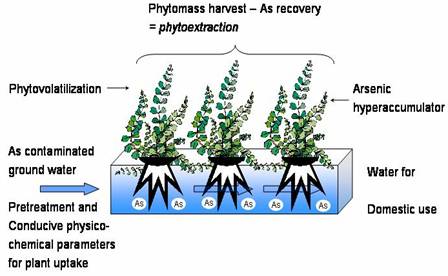
Figure 3: Removal of Arsenic from ground water using macrophytes by phytovolatilization ( Aksorn and Visoottiviseth 2004).
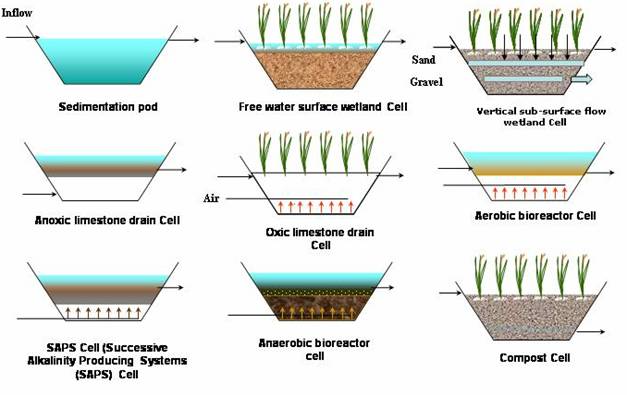
Figure 4: Constructed wetland technology for treatment of municipal waste waters using macrophytes
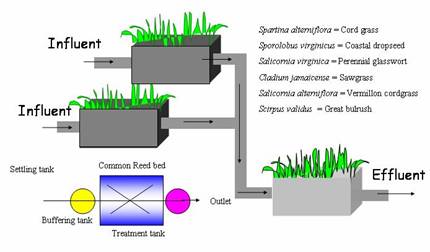
Figure 5: Cascade model of constructed Aquaplant with cmmon reed beds or grasses for the removal of xenobiotics and treatment of saline waste streams. The commonly used grasses for the treatment of saline waste strems are Spartina alterniflora = Cord grass, Sporolobus virginicus = Coastal dropseed; Salicornia virginica = Perennial glasswort; Cladium jamaicense = Sawgrass; Salicornia alterniflora = Vermillon cordgrass; and Scirpus validus = Great bulrush
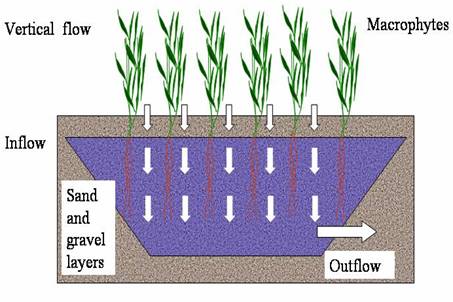
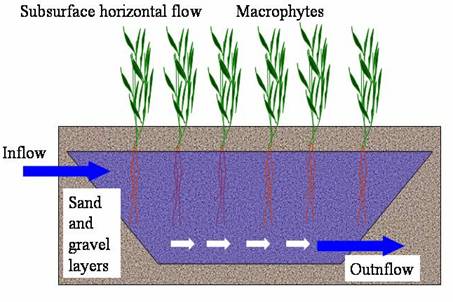
Figure 6: Constructed wetland for removal waste water Figure 7: Constructed wetland for removal waste water treatment
treatment (Vertical flow system with macrophytes) (Horizontal flow with macrophytes)
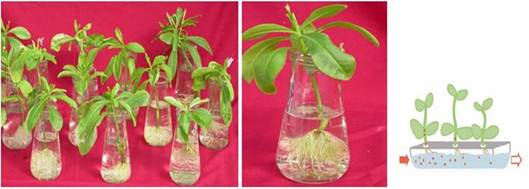
Figure 8: Ideal system for assessing the rhizofiltration in hydropinics using Talinum cuneifolium (Portulacaceae)
Potential role of aquatic plants in phytotechnology :
Phytoremediation is defined as the use of plants for environmental cleanup (Prasad 2007). (Table 2 and 3) Aquatic macrophytes have paramount significance in the monitoring of metals in aquatic ecosystems (eg: Lemna minor, Eichhornia crassipes, Azolla pinnata) Aquatic plants are represented by a variety of macrophytes including algal species that occur in various habitats. They are important in nutrient cycling, control of water quality, sediment stabilisation and provision of habitat for aquatic organisms. The use of aquatic macrophytes in water quality assessment has been a common practice employing in-situ biomonitors (Sobolewski 1999)
Table 2: Aquatic plants for and biomonitoring of toxic trace elements in a wide range of toxicity bioassays
(Prasad 2007, Prasad (2001a,b, 2004 a,b, 2006, 2007, Prasad and Freitas 2003, Prasad et al 2001, 2006 )
Plant species |
Metal |
Azolla fililiculioides |
Cr, Ni, Zn, Fe, Cu, Pb |
A. pinnata |
Cd, Cr, Zn |
Bacopa monnieri |
Hg, Cr, Cu, Cd |
Carex juncell |
Cu, Pb, Zn, Co, Ni, Cr, Mo, U |
Carex rostrata |
Cu, Pb, Zn, Co, Ni, Cr, Mo, U |
Carex Sp. |
Cd, Fe, Pb.,Mn |
Ceratophyllum demersum |
Cd, Cu, Cr, Pb, Hg, Fe, Mn. Zn, Ni, Co and radionuclides |
Cyperus eragrostis |
Cd, Cu, Pb, Zn |
Distichlis spicata |
Cd, Fe, Pb, Mn |
Elodea densa |
Hg, methyl-Hg |
E. nuttallia |
Cu |
E. sptangulare |
Hg, Pb, Cd, Cu and Fe |
Eichhornia crassipes |
As, Cd, Co, Cr Cu, Al, Ni, Pb, Zn, Hg, P, Pt, Pd, Os, Ru, Ir, Rh |
Elodea canadensis |
Cu, Pb, Cd, Zn, Cr, Ni |
Eriocaulon septangulare |
Hg, Pb, Cd, Fe |
Euryale ferox |
Cd,Cr,Pb, Cu |
Hydrilla verticillata |
Hg, Fe, Ni, Hg, Pb |
Hygrophila onogaria |
Hg, methyl-Hg |
Isoetes lacustris |
Cu. Pb |
Lemna minor |
Mn, Pb, Ba, B, Cd, Cu, Cr, Ni, Se, Zn, Fe |
L. trisulca |
Cu, Cd |
L. gibba |
Cu, Cd |
L. palustris |
Zn, Cu, Fe, Hg |
L. paucicostata |
Cd, Zn, EDTA, Cu, Ca |
L. perpusilla |
Cd |
L. polyrrhiza |
Cd |
L. valdivinia |
Cd, Cu |
Littorella uniflora |
Cu, Pb |
Ludwigia natans |
Hg, methyl-Hg |
Lysimachia nummularia |
Hg, methyl-Hg |
Myriophyllum spicatum |
Cd, Cu, Zn, Pb, Ni, Cr |
M. alterniflorum |
Cu, Pb |
M. exalbescens |
Zn, Pb |
M. aquaticum |
Zn, Cu, Fe, Hg, Cd, Pb |
Melilotus indica |
Se |
Mentha aquatica |
Cd, Zn, Cu, Fe, Hg |
Najas marina |
Cd, Fe, Pb, Mn |
Nasturtium officinale |
Cd |
Nuphar lutea |
Cu, Ni, Cr, Co, Zn, Mn, Pb, Cd, Hg, Fe |
N. variegatum |
Cu, Zn |
Nymphaea alba |
Ni, Cr, Co, Zn, Mn, Pb, Cd, Cu, Hg, Fe |
Nymphoides germinate |
Cd, Cu, Pb, Zn |
Potamogeton attenuatum |
Cd, Cu. Pb. Zn |
P. communis |
Ni, Cr, Co, Zn, Mn, Pb, Cd, Cu, Hg, Fe |
P. crispus |
Cu, Pb, Mn, Fe, Cd |
P. filiformis |
Cd, Fe, Pb, Mn |
P. lapathifoilum |
Cd, Cu, Pb, Zn |
P. orientalis |
Cd, Cu, Pb, Zn |
P. pectinatus |
Mn. Pb, Cd, Cu, Cr, Zn, Ni, As, Se |
P. perfoliatus |
Cu, Pb, Cd, Zn, Ni, Cr |
P. richardsonii |
Cd, Cr, Cu, Ni, Zn, Pb |
P. subsessiles |
Cd, Cu. Pb. Zn |
Phragmites karka |
Cr |
Pistia stratoites |
Cu, Al, Cr, P, Hg |
Ranunculus aquatilis |
Mn, Pb, Cd, Fe, Pb, |
R. baudotii |
Cd, Cu, Cr, Zn, Ni, Pb |
Ruppia maritima |
Mn, Pb, Cd, Pb, Fe, Se |
Salvinia acutes |
Mn, Pb |
S. maritimus |
Cd, Fe, Pb, Mn |
S. natans |
Pb, Cr |
S. undulata |
Pb |
S. molesta |
Hg |
Scapania uliginosa |
B, Ba, Cd, Co, Cr, Cu, Li, Mn, Mo, Ni, Pb, Sr, V, Zn |
Schoenoplectus lacustris |
Ni, Cr, Co, Zn, Mn, Pb, Cd, Cu, Hg, Fe |
Scirpus lacustris |
Cr |
Spirodela polyrhiza |
Cr |
Typha domingensis |
Cd, Cu, Pb, Zn |
T latifolia |
Ni, Cr, Co, Zn, Mn, Pb, Cd, Cu, Hg, Fe |
Vallisneria americana |
Cd, Cr, Cu, Ni, Pb, Zn |
V. spiralis |
Hg |
Wolffia globosa |
Cd, Cr |
Table 3: Aquatic macrophyts a for phytotechnologies to treat inorganic pollutants, acid mine drainage, salt water, regulation of storn water and removal of radionuclides. For details of experiments (field and laboraroty), reference may be made to COST action 837, 2003 and COST action 859, 2005, Hattink et al 2000, McCutcheon and Schnoor 2003, Peles et al 2002, Prasad (2001a,b, 2004 a,b, 2006, 2007, Prasad and Freitas 2003, Prasad et al 2001, 2006 )
Plant name |
Common name |
Phytormediation function |
Azolla filiculoides |
Water fern |
Metals hyperaccumulation |
Bacopa monnieri |
Water hyssop |
Metals accumulation |
Canna flaccida |
|
HM removal in constructed wetland |
Carex pedula |
|
HM removal in constructed wetland |
Chara, Nitella, Mougeotia, Ulothrix |
Algae |
If they could be induced to grow mining effluents, they would provide a simple, long-term solution remove U and other radionuclides |
Cladium Jamaicense |
Sawgrass |
Brine concentration |
Eichhornia crassipes |
Water hyacinth |
Metals accumulation and biosorption |
Elodea canadensis |
|
Phytofiltration of storm water and removal of zinc |
Eriophorum angustifolium |
|
Phytostabilization of metal rich mine tailings |
Eriophorum scheuchzeri |
|
Phytostabilization of metal rich mine tailings |
Glyceria fluitans |
|
Phytostabilization of mine tailings, treatment of acid mine drainage |
Hydrilla verticillata |
- |
TNT transformation and metals accumulation |
Hydrocotyle umbellata |
Pennywort |
Biosorption of toxic metals |
Ipomea aquatics |
Water spinach |
Metals accumulation |
Juncus articulatus |
|
Phytostabilization of mine tailings |
Lemna minor |
Duck weed |
Concentrates technetium-99 |
Lemna, Spirodela and Wolffia |
Duckweeds |
Biosorbents of inorganic and organic pollutants and metals accumulation |
Miscanthus floridulus |
|
HM removal in constructed wetland |
Miscanthus sacchariflorus |
|
HM removal in constructed wetland |
Nymphaea violacea |
waterlily |
uranium and thorium series radionuclides |
Pistia stratiotes |
Water lettuce |
Metals accumulation |
Polygonum punctatum |
|
radiocesium ( 137 Cs) |
Potamogeton natans |
|
Phytofiltration of storm water and removal of zinc |
Potamogeton natans |
- |
Metals uptake |
Sagittaria latifolia |
|
radiocesium ( 137 Cs) |
Salvinia molesta |
Kariba weed |
Metals accumulation |
Scirpus spp |
Bulrush |
Used in constructed wetland |
Scirpus validus |
- |
Brine concentration |
Spartina alterniflora |
Cordgrass |
Saltwater, brine concentration |
Spirodela oligorrhiza |
Giant duckweed |
metals accumulation |
Sporobolus virginicus |
Coastal dropseed |
Brine concentration |
Tamarix spp. |
Salt cedar |
Hydraulic control of arsenic |
Vallisneria spiralis |
Eel grass |
Metals hyperaccumulation |
Zizania aquatica |
wild rice |
Uptake of 129 I. |
The submerged aquatic macrophytes have very thin cuticle and therefore readily take up metals from water through the entire surface. Hence, the integrated amounts of biologically available metals in water and sediment can be indicated to some extent by using macrophytes. Macrophytes with their ability to survive adverse conditions and high colonisation rate are excellent tools for phytoremediation. Further they redistribute metals from sediments to water and finally take up in the plant tissues and hence maintain circulation. Benthic rooted macrophytes (both submerged and emergent) play an important role in metal bioavailability from sediments through rhizosphere exchanges and other carrier chelates. This naturally facilitates metal uptake by other floating and emergent forms of macrophytes. Macrophytes readily take up metals in their reduced form from sediments, which exist in anaerobic situations due to lack of oxygen and oxidise them in the plant tissues making them immobile and hence bioconcentrate them to a high extent Okurut et al 1999)
Constructed wetlands are man-made wetlands designed to intercept and remove a wide range of contaminants from water. These wetlands can save you time and money by using natural mechanisms to treat non-point source pollution before it reaches our lakes, rivers, and oceans. Oils, nutrients, suspended solids, and other substances are non-point source pollutants. These pollutants originate mainly from non-point sources, which are difficult to control. Conventional wastewater treatment plants can effectively remove non-point source pollution, but are expensive to build and operate.
Treatment mechanisms :
-
1Filtration and uptake of contaminants.
-
Settling of suspended solids due to decreased water velocity and trapping action of plants, leaves, and stems.
-
Precipitation, adsorption, and sequestration of metals.
-
Microbial decomposition of petroleum hydrocarbons and other organics
Benefits :
-
Cost-effective treatment of non-point source pollution.
-
Compliance with water quality goals.
-
Reduction of operation and maintenance costs relative to conventional water treatment plants.
-
Conservation of natural resources.
-
Reduction of flood hazard and erosion.
-
Creation of wildlife habitat and aesthetic resources.
Plants may reduce element leakage from submerged mine tailings by phytostabilisation. However, high shoot concentrations of elements might disperse them and could be harmful to grazing animals. Plants that are tolerant to elements of high concentrations have been found useful for reclamation of dry mine tailings containing elevated levels of metals and other elements. Mine tailings rich in sulphides, e.g. pyrite, can form acid mine drainage (AMD) if it reacts with atmospheric oxygen and water, which may also promote the release of metals and As. To prevent AMD formation, mine tailings rich in sulphides may be saturated with water to reduce the penetration of atmospheric oxygen. An organic layer with plants on top of the mine tailings would consume oxygen, as would plant roots through respiration.
Thus, phytostabilisation on water-covered mine tailings may further reduce the oxygen penetration into the mine tailings and prevent the release of elevated levels of elements into the surroundings. Metal tolerance can be evolutionarily developed while some plant species seem to have an inherent tolerance to heavy metals. Since, some wetland plant species have been found with the latter property, for example Thypha latifolia, Glyceria fluitans and Phragmites australis, wetland communities may easily establish on submerged mine tailings, without prior development of metal tolerance. The relationships between element concentrations in plants and concentrations in the substrate differ between plant species. Some plant species have mechanisms that make it possible to cope with high external levels of elements. Low-accumulators are plants that can reduce the uptake when the substrate has high element concentrations, or have a high net efflux of the element in question, thus the plant tissue concentration of the element is low even though the concentration in the substrate is high (Williams 2002., Wood and Mcatamney 1994, Woulds and Ngwenya 2004, and Ye et al 2001)
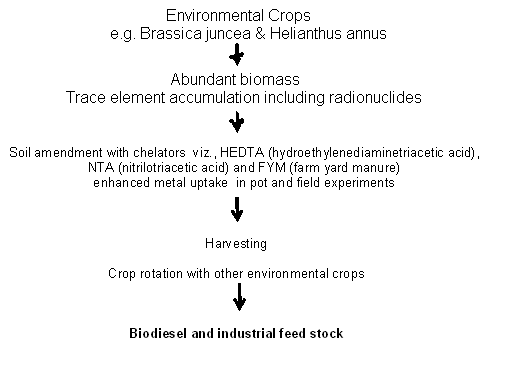
Figure 9: Environmental crops for phytoremediation of heavy metal polluted soils
Conclusions :
-
Promising environmental crops e.g. kenaf, brassica, sunflower, tobacco etc. based phytotechnologies need to be evaluated for implementation in Indian scenario (Prasad 2006) (Figure 9). A community of tree, legume and grass based phytoremediation systems would be advantageous.
-
Ned to identify/ establish low cost, effective and environmentally friendly chelators for enhancing bioconcentration of toxic metals
-
Adverse environmental implications of use of chelators on ground water and development of refined techniques for separating heavy metals from the phytomass of hyper accumulators needs critical investigation.
-
Indigenous plants that hyperaccumulate heavy metals and eventually bioprospection is a long way to achieve success in phytomining. Detailed studies on indigenous Brassicaceae for metal accumulation need to be conducted. Ientification of indigenous sources of biomass for removal of specific metals from aqueous solutions, identification indigenous clays/minerals for biosorption of toxic metals would be worth attempting
-
Examination of mycorrhizal associations for remediation of metallifersous and coal fly ash is a promising area. Plant community studies tolerant to toxic trace metals for restoration of the degraded mines oils , In-depth analysis of indigenous ferns for arsenic hyperaccumulation would contribute to sustainable development of metalliferous soils.
-
Studies on the molecular mechanisms of plant metal tolerance, expression of potentiaql candidate genes from promising organisms and production of genetically transformed plants over expressing ?-glutamyl cysteine synthetase will have metal tolerance and field applications.
-
Studies on the ligands exuded by plants in rhizosphere, rhizosphere biotechnology of indegenous plants to facilitate metal accumulation, plants with concurrent ability for uptake of heavy metals and persistent organic pollutants from soil through soil-rhizosphere-plant continuum, accumulation of potentially toxic elements in edible plants and their transfer to human food chain need further focused research.
-
Surface flow constructed wetlands are being designed for the treatment of municipal wastewaters in developed nations. Use of constructed wetlands is spreading rapidly in developed nations how ever, in tropical nations due to water scarcity and high surface evapotranspitration the constructed wetlands for treatment of wastewaters is not gaining significance. Further due to water scarcity wetland technology is not supported. However, in tropical contries the mine drainage, agricultural waste waters and flood water regulation there is considerable scope due to rich plant diversity.
-
Inspite of certain limitations, there are several advantages for application of phytoremediaiton particularly when it is based on commonly cultivated crops such as Brassica juncea, Armoracia rusticana and Helianthus annuus (Prasad 2004). Plants that are amenable to genetic manipulation and in vitro culture play significant role for the success of phytoremediation.
References :
1Adriano , D.C. , Wenzel, W.W., Vangronsveld, J. And Bolan, N.S. (2004). Role of assisted natural remediation in environmental cleanup. Geoderma 122: 121-142.
Aksorn E and Visoottiviseth P. (2004). Selection of suitable emergent plants for removal of arsenic from arsenic contaminated water. ScienceAsia 30 (2004): 105-113
APHA. American Public Health Association. (1998). Standard methods for estimation of water and wastewater. 20 ed. Ed: Eaton, D. D. , Clesceri, L. S. and Greenberg, A. E. Washington D.C.
COST Action 837. (2003). T. Vanec, J.-P. Schwitzguebel (eds). UOCHB AVCR, Prague , pp 41.
COST Action 859. (2005) J.-P. Schwitzguebel (ed).Phytotechnologies to promote sustainable land use and improve food safety.
Fritioff, Å., Greger, M. (2003). Aquatic and terrestrial plant species with potential to remove heavy metals from stormwater. Int. J. Phytorem. 5: 211-224.
Glass, D.J. (1999) U.S. and international markets for phytoremediation, 1999-2000. Needham , Mass. , D. Glass Associates, p. 266.
Hattink, J., de Goeij, J. J. M., Wolterbeek, H. T. H. (2000). Uptake kinetics of 99 Tc in common duckweed. Environ. Exp. Bot. 44:9-22.
Kadlec, R.H. And Knight, R.L. (Eds.) (1996) Treatment Wetlands. Lewis Publishers, Boca Raton . 893p.
Kadlec, R.H., (1995). Overview: Surface flow constructed wetlands. Water Science and Technology 32 (3), 1–12.
Kamal, M., Ghaly, A. E., Mahmoud, N., and Côté, R. (2004). Phytoaccumulation of heavy metals by aquatic plants. Environment International . 29: 1029-1039.
Lytle, C. M., Lytle, F. W., Yang, N., Qion, J. H., Hansen, D., Zayed, A., and Terry, N. (1998). Reduction of Cr (VI) to CR (III) by wetland plants: Potential for in situ heavy metal detoxification. Environ. Sci. Technol. 32: 3087–3093.
McCutcheon , S.C. and Schnoor, J.L (eds) (2003). Phytoremediation – transformation and control of contaminants. Wiley Interscience. Pp. 985.
Mohan, B.S. and Hosetti, B.B., (1999). Aquatic plants for toxicity assessment, Environ. Res. 81: 259-274.
Okurut, T. O., Rijs, G. B. J., And Van Bruggen, J. J. A. (1999). Design and performance of experimental constructed wetlands in Unganda, planted with Cyperus papyrus and Phragmites mauritianus. Water Science and Technology 40 (3): 265-271.
Peles, J.D., Smith, M.H., and Brisbin, Jr.I.H., (2002). Ecological half-life of 137 Cs in plants associated with a contaminated stream, J Envir Radioactivity, 59:169-178.
Prasad, M.N.V (2006) Stabilization, remediation and integrated management of metal-contaminated ecosystems by grasses (Poaceae) In, M.N.V Prasad, K.S.Sajwan, and Ravi Naidu (Eds) Trace elements in the environment: Biogeochemistry, Biotechnology and Bioremediation. CRC Press , Florida , USA (Taylor and Francis) Chap. 21 , pp. 405-424
Prasad, M.N.V. (2001) Metals in the environment: analysis by biodiversity . New York , Marcel Dekker , , New York . pp. 504.
Prasad, M.N.V. (2004a) Phytoremediation of metals in the environment for sustainable development. Proc Indian Nanl Sci Acad 70(1) : 71-98
Prasad, M.N.V. (ed) (2004b). Heavy metal stress in plants: from biomolecules to ecosystems. Springer-Verlag Heidelberg . 2 nd Ed. pp. 462+xi
Prasad, M.N.V. (2006) Sunflower ( Helianthus annuus L.) - a potential crop for environmental industry. 1st International Symposium on Sunflower Industrial Uses. Faculty of Agriculture Udine , Italy September 11 - September 13, 2006
Prasad, M.N.V. (2007) Aquatic plants for phytotechnology. In S.N.Singh and R.D.Tripathi (eds) Environmental Bioremediation technologies. Springer. Pp. 257-274
Prasad, M.N.V. (2001). Bioremediation Potential of Amaranthaceae In: A.Leeson, E.A. Foote, M.K. Banks, and V.S. Magar (Eds.), Phytoremediation, Wetlands, and Sediments, Vol. 6(5):165-172. Proc, 6 th Int In Situ and On-Site Bioremediation Symposium , Battelle Press, Columbus , OH .
Prasad, M.N.V. and H. Freitas (2003) Metal hyperaccumulation in plants – Biodiversity prospecting for phytoremediation technology. Electronic J. of Biotechnology 6(3):275-321 Online http://www.ejbiotechnology.info/content/vol6/issue3/index.html
Prasad, M.N.V., M. Greger and P.Aravind. (2006) Biogeochemical cycling of trace elements by aquatic and wetland plants: relevance to phytoremediation. In, M.N.V Prasad, K.S.Sajwan, and Ravi Naidu (Eds) Trace elements in the environment: Biogeochemistry, Biotechnology and Bioremediation. CRC Press , Florida , USA (Taylor and Francis) Chap. 24, pp. 451-482
Prasad, M.N.V.,Greger, M., and Smith, B.N., (2001) Aquatic macrophytes, in Metals in the Environment: Analysis by biodiversity , Prasad, M.N.V., (Ed). Marcel Dekker Inc., New York , 259.
Sobolewski, A. 1999. A review of processes responsible for metal removal in wetlands treating contaminated mine drainage. Int. J. Phytorem. 1: 19-51.
Wang W, Freemark K. 1995. The use of plants for environmental monitoring and assessment. Ecotoxicol Environ Safety;30:289-301.
Weis, J. S., and Weis, P.,2004. Metal uptake, transport and release by wetland plants:implications for phytoremediation and restoration. Environment International . 30:685-700.
Williams, J.B, 2002. Phytoremediation in wetland ecosystems: progress, problems, and potential. Critical Reviews in Plant Sciences 21 (6), 607–635.
Wood, B., Mcatamney, C., 1994. The use of macrophytes in bioremediation. Biotechnology Advances 12, 653–662.
Woulds, C., Ngwenya, B.T., 2004. Geochemical processes governing the performance of a constructed wetland treating acid mine drainage, Central Scotland . Applied Geochemistry 19 (11), 1773–1783.
Ye, Z.H., Whiting, S.N., Qian, J.H., Lytle, C.M., Lin, Z.Q., Terry, N., 2001. Wetlands and aquatic processes, trace elements removal from coal ash leachate by a 10 year old constructed wetland. Journal of Environmental Quality 30, 1710–1719.